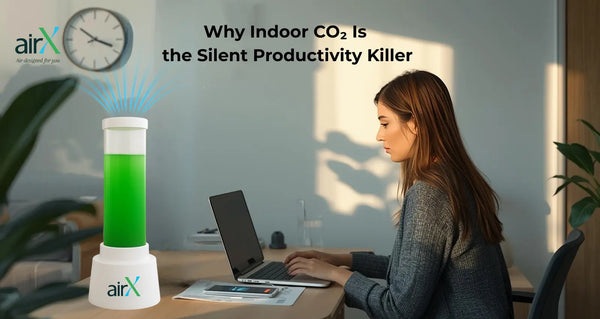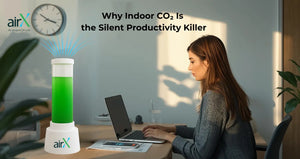Why Indoor CO₂ Is the Silent Productivity Killer

Why Indoor CO₂ Is the Silent Productivity Killer
When we think of “pollution,” our minds often jump to smoke-filled skies, traffic jams, or factory chimneys. But some of the most dangerous pollutants never leave your home. They linger quietly in your bedroom, office, and children’s study rooms. The biggest culprit? Carbon dioxide (CO₂).
Most people don’t realize that indoor CO₂ levels can be 3–5 times higher than outdoor air, especially in Indian metros like Delhi, Mumbai, and Bengaluru. While we obsess over PM2.5 or dust, we ignore CO₂—the invisible gas that silently drains our energy, clarity, and focus.
The Numbers Don’t Lie: CO₂ Indoors Is Rising Fast
According to ASHRAE (American Society of Heating, Refrigerating, and Air-Conditioning Engineers), indoor CO₂ levels should ideally stay below 600–800 ppm. Yet, in many Indian homes and offices, it routinely crosses 1,000 ppm. In poorly ventilated rooms, levels can rise to 1,500–2,000 ppm overnight.
Why does this happen?
-
Closed rooms: Windows and doors keep outdoor noise and dust away but also trap exhaled CO₂.
-
Air conditioners: They recirculate stale air instead of bringing in fresh oxygen.
-
Daily activities: Cooking, appliances, and even human breathing add to the CO₂ load.
This invisible buildup doesn’t just affect the air. It directly affects your brain.
Harvard’s Alarming Finding: 20% Drop in Productivity
A landmark Harvard study revealed that high indoor CO₂ levels cause a 20% decline in cognitive scores. Put simply: every time CO₂ climbs above 1,000 ppm, you start thinking slower, making poorer decisions, and losing concentration.
Real-life symptoms include:
-
Afternoon fatigue even if you slept well.
-
Trouble focusing during work or study.
-
Foggy memory and decision delays.
Think of it as running your laptop without enough battery—performance dips, crashes increase, and efficiency plummets. Your brain works the same way in CO₂-heavy environments.
The Emotional Cost of Breathing Wrong
Numbers aside, there’s also a human side. Parents wonder why their child is cranky after sleeping in a closed room. Professionals can’t explain why they’re constantly drained despite healthy diets and exercise. Elderly family members complain of headaches, unaware the culprit is air—not age.
The tragedy is that we blame ourselves instead of the air around us.
Why Traditional Purifiers Don’t Solve This
Conventional air purifiers focus on PM2.5 and dust. HEPA filters trap particles, yes—but they don’t reduce CO₂ or add oxygen. So while your purifier hums in the corner, your room may still feel heavy, stale, and fatiguing.
That’s why the solution needs to go beyond filtration.
AirX: India’s First Living Oxygen Generator
AirX was designed for exactly this hidden crisis. Instead of trapping air, it transforms it. Powered by advanced microalgae biotechnology, every AirX device acts like a digital plant:
-
Absorbs CO₂ continuously from indoor spaces.
-
Releases fresh oxygen, restoring the balance your body craves.
-
Generates oxygen equal to 60 plants in just 2 ft² of space.
-
Works even in low-ventilation rooms like bedrooms, yoga corners, and offices.
Unlike purifiers, AirX doesn’t rely on disposable filters. Its algae culture only needs a simple 90-day nutrient refill, making it sustainable, cost-effective, and eco-friendly.
Productivity Meets Wellness
Imagine starting your workday in a room that doesn’t just look fresh but actually feels alive. With AirX, you’ll notice:
-
Sharper focus during meetings and tasks.
-
Less mid-day fatigue.
-
Better decision-making and memory recall.
-
A calmer, more refreshing environment overall.
For families, this means children study with clarity, parents sleep deeper, and elders breathe easier. For offices, it means healthier employees and fewer productivity losses.
From Numbers to Nurture
Let’s put it in perspective:
-
Every 400 ppm rise in CO₂ can reduce cognitive function by 15–20%.
-
An AirX device keeps CO₂ levels low and oxygen levels high—bringing you closer to the clarity of a mountain retreat.
It’s not just science. It’s common sense: when you give your brain better fuel, it gives you better results.
Final Thought: Your Breath, Your Power
You work hard to create opportunities for yourself and your family. Don’t let invisible CO₂ steal your clarity, energy, or sleep.
AirX is more than a device—it’s a living wellness companion. It takes care of the air, so you can take care of what really matters: living, learning, and achieving.
Sources:
-
Allen, J.G., et al. “Associations of Cognitive Function Scores with Carbon Dioxide, Ventilation, and VOC Exposures in Office Workers.” Environmental Health Perspectives (2016). PubMed
-
ASHRAE Indoor CO₂ Ventilation Guidelines. ashrae.org
-
Harvard T.H. Chan School of Public Health: “Office air quality may affect employees’ cognition, productivity.” Harvard News








